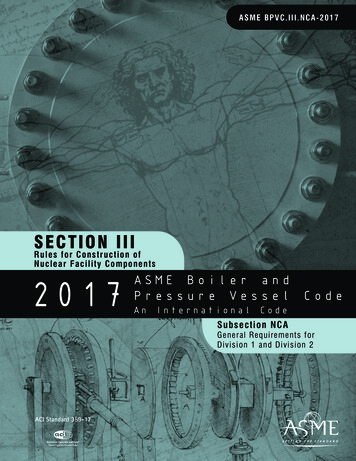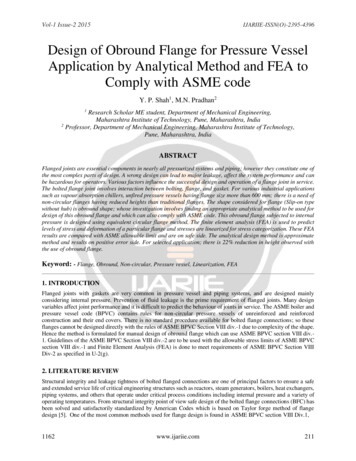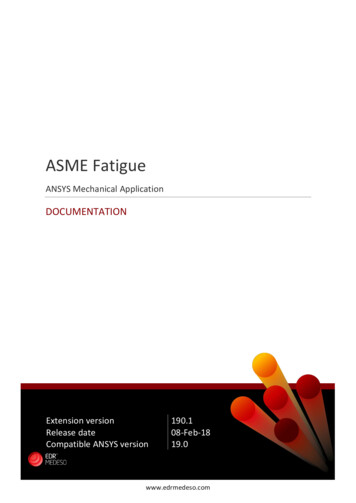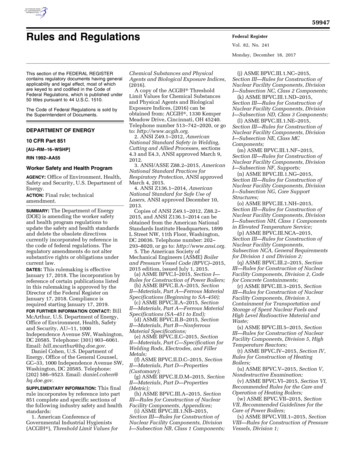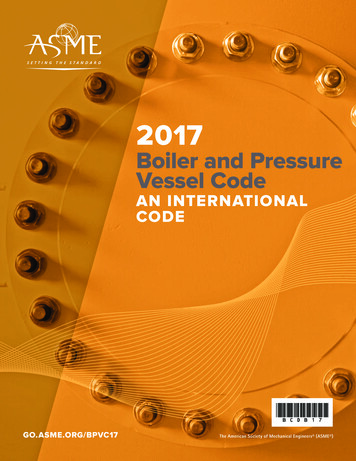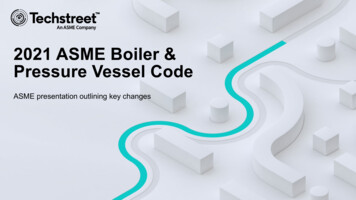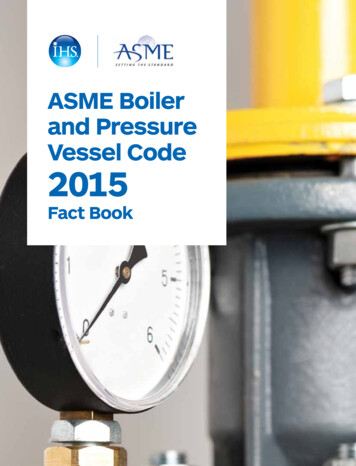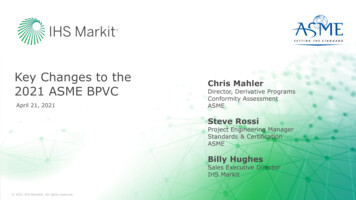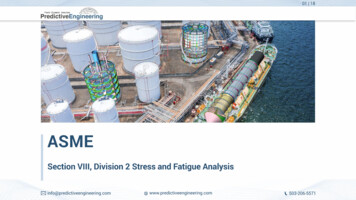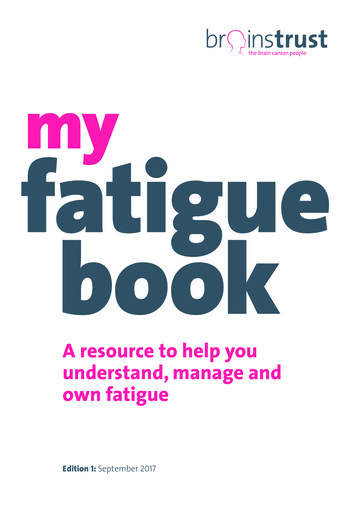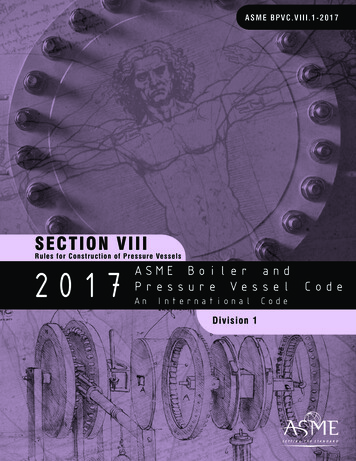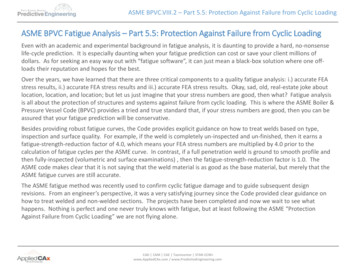
Transcription
ASME BPVC.VIII.2 – Part 5.5: Protection Against Failure from Cyclic LoadingASME BPVC Fatigue Analysis – Part 5.5: Protection Against Failure from Cyclic LoadingEven with an academic and experimental background in fatigue analysis, it is daunting to provide a hard, no-nonsenselife-cycle prediction. It is especially daunting when your fatigue prediction can cost or save your client millions ofdollars. As for seeking an easy way out with “fatigue software”, it can just mean a black-box solution where one offloads their reputation and hopes for the best.Over the years, we have learned that there are three critical components to a quality fatigue analysis: i.) accurate FEAstress results, ii.) accurate FEA stress results and iii.) accurate FEA stress results. Okay, sad, old, real-estate joke aboutlocation, location, and location; but let us just imagine that your stress numbers are good, then what? Fatigue analysisis all about the protection of structures and systems against failure from cyclic loading. This is where the ASME Boiler &Pressure Vessel Code (BPVC) provides a tried and true standard that, if your stress numbers are good, then you can beassured that your fatigue prediction will be conservative.Besides providing robust fatigue curves, the Code provides explicit guidance on how to treat welds based on type,inspection and surface quality. For example, if the weld is completely un-inspected and un-finished, then it earns afatigue-strength-reduction factor of 4.0, which means your FEA stress numbers are multiplied by 4.0 prior to thecalculation of fatigue cycles per the ASME curve. In contrast, if a full penetration weld is ground to smooth profile andthen fully-inspected (volumetric and surface examinations) , then the fatigue-strength-reduction factor is 1.0. TheASME code makes clear that it is not saying that the weld material is as good as the base material, but merely that theASME fatigue curves are still accurate.The ASME fatigue method was recently used to confirm cyclic fatigue damage and to guide subsequent designrevisions. From an engineer’s perspective, it was a very satisfying journey since the Code provided clear guidance onhow to treat welded and non-welded sections. The projects have been completed and now we wait to see whathappens. Nothing is perfect and one never truly knows with fatigue, but at least following the ASME “ProtectionAgainst Failure from Cyclic Loading” we are not flying alone.CAD CAM CAE Teamcenter STAR-CCM www.AppliedCAx.com / www.PredictiveEngineering.com
ASME BPVC.VIII.2 – Part 5.5: Protection Against Failure from Cyclic LoadingASME Fatigue Code Application – Non-Pressure Vessel ApplicationThe ASME BPVC.VIII.2 – Part 5.5 code provides a straight-forward approach for classical fatigue analysis of welded structures.CAD CAM CAE Teamcenter STAR-CCM www.AppliedCAx.com / www.PredictiveEngineering.com
ASME BPVC.VIII.2 – Part 5.5: Protection Against Failure from Cyclic LoadingFatigue of Welded Structures: Weld Surface Fatigue Reduction FactorsThe ASME Section VIII, Division 2 “Design-by-Analysis” code provides an industry accepted criteria for the classification of welds.If the weld is left in its as-welded condition, then the Fatigue-Strength-Reduction Factor is 4.0. From a FEA perspective, thismeans that the calculated stress numbers are multiplied by 4x and then applied to the ASME fatigue curves. The utility of thisapproach is that the engineer can provide clear justification for weld quality improvements to obtain lower Fatigue-StrengthReduction Factors (FSRF).CAD CAM CAE Teamcenter STAR-CCM www.AppliedCAx.com / www.PredictiveEngineering.com
ASME BPVC.VIII.2 – Part 5.5: Protection Against Failure from Cyclic LoadingWeld Quality Levels: As-Welded (4.0) to Machine Profiled, Fully-Inspected (1.0)As-Welded ConnectionMachine Ground, Tapered and Fully-InspectedA section of the welded structure is shown above in the as-welded condition and then after weld-preparation. In the as-weldedcondition with no inspection, the ASME Section 5.5 Protection Against Failure from Cyclic Loading requires a Fatigue-StrengthReduction Factor of 4x. To obtain a Factor of 1x, our client ground the full penetration weld surface to a smooth continuousprofile and then performed a full-inspection per the Code requirements.CAD CAM CAE Teamcenter STAR-CCM www.AppliedCAx.com / www.PredictiveEngineering.com
ASME BPVC.VIII.2 – Part 5.5: Protection Against Failure from Cyclic LoadingApplication of ASME Fatigue Code: Effective Total Equivalent Stress AmplitudeElastic Stress Analysis and Equivalent StressesThe calculation of the effective total equivalent stress amplitude appears complex, but it really just boils down to enveloping themaximum and minimum principal stresses in the fatigue load sets. For example, one has 20 load sets and then envelopes the maxand min stresses (35,000 – (-16,000)) which yields an effective equivalent stress range of 51,000. To arrive at the ASME fatiguestress one uses equation 5.30, whereas Salt, k {51,000 (Fatigue-Strength-Reduction Factor)}/2. However, it is all about your weldquality and given your weld quality level, one can have an Effective Total Equivalent Stress Amplitude of 25,500 (FSRF 1) or102,000 (FSRF 4).CAD CAM CAE Teamcenter STAR-CCM www.AppliedCAx.com / www.PredictiveEngineering.com
ASME BPVC.VIII.2 – Part 5.5: Protection Against Failure from Cyclic LoadingApplication of ASME Fatigue Code: 3-F.1 ASME Smooth Bar Fatigue CurvesAlternative Effective Stress vs Fatigue Cycles (S-N Curve)With your weld quality level assessed and an accurate FEA stress number, one can use the ASME fatigue curve to calculate thenumber of Fatigue Cycles. In our prior example, the fatigue stress could be 25.5 ksi or as high as 102 ksi, depending on the fatiguestrength reduction factor. Working with the ASME smooth bar fatigue curves, the number of cycles to failure could be 70,000 or aslow as 800. This fundamentally explains the challenge engineers can have with fatigue predictions of welded structures. Please keepin mind that the ASME fatigue curve has been adjusted by 2 or 20, to arrive at a clean curve that accounts for material variability.CAD CAM CAE Teamcenter STAR-CCM www.AppliedCAx.com / www.PredictiveEngineering.com
ASME BPVC.VIII.2 – Part 5.5: Protection Against Failure from Cyclic LoadingApplication of ASME Fatigue Code: More Than Just Boilers and Pressure VesselsOur experience with the ASME Section VIII, Division 2 Alternative Rules, or as we like to say “Design-by-Analysis”, allows us toaccurately, quickly and safely certify structures and systems for fatigue loading. Our experience has been gained over 20 years offinite element analysis consulting. We are practical, hands-on engineers with a background in manufacturing, experimentalmechanics and of course, getting our hands dirty when we are not pounding on the keyboard. If you have any questions or wouldlike to send us a project to analyze, please contact us at www.PredictiveEngineering.com.CAD CAM CAE Teamcenter STAR-CCM www.AppliedCAx.com / www.PredictiveEngineering.com
A section of the welded structure is shown above in the as-welded condition and then after weld-preparation. In the as-welded condition with no inspection, the ASME Section 5.5 Protection Against Failure from Cyclic Lo
